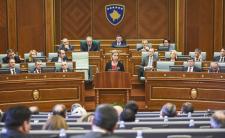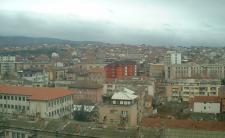Constitutional history
During the medieval era, Kosovo was the administrative and cultural center of the Serbian empire. In the 14th century, the Ottoman Turks conquered Serbia, bringing Kosovo under Ottoman rule. This rule lasted for over four centuries, until the First Balkan War in 1912-1913 ended Ottoman supremacy. Under Ottoman rule, Kosovo was split into four parts: three belonging to Serbia, and one to Montenegro. Following the First Balkan War, Kosovo was divided among Serbia, Montenegro, and Albania at the Treaty of London in May 1913. Anti-Serbian sentiment was pervasive within Kosovo as the majority of the population were not ethnic Serbs, but instead Albanians.
The peace treaties of 1919-1920 established a Yugoslav state called “The Kingdom of Slovenes, Croats, and Serbs,” which was shortly changed to Yugoslavia. The Kingdom contained 12 million people, 400,000 of which were Albanian. In contrast, within Kosovo, 64% of the population was Albanian, three-quarters of which were Muslim. Hostilities between Serbs and Albanians in Kosovo re-emerged, and Kosovo requested from the League of Nations that it be united with Albania. The League took no action.
Following World War II, Kosovo became an autonomous region of Serbia within the Socialist Federal Republic of Yugoslavia, under Marshall Tito's communist regime. With the passing of the Yugoslav Constitution in 1974, Kosovo gained the status of a Socialist Autonomous Province within Serbia. Tito died in 1980, and tensions between Serbs and ethnic Albanians within Kosovo intensified. In 1981, Albanian students organized protests seeking to make Kosovo a republic within Yugoslavia. The protests intensified into widespread violent riots involving over 20,000 people.
During the 1980s, the provincial government in Kosovo began to discriminate against the Serbian population in the province, which escalated into “ethnic cleansing.” This discrimination caused many Serbs to migrate out of Kosovo. Despite this, Communist authorities in Belgrade ignored the Kosovo Serbs, causing more resentment among them.
In the late 1980s, Slobodan Milosevic rose to power on a surge of Serbian nationalism. By the end of 1987, he had full control over the Serbian government. In 1989, Milosevic revoked Kosovo's autonomy, bringing it under direct Belgrade control. Serbia implemented a new constitution, which on the surface guaranteed a multi-party system, freedom of speech, and basic human rights. However, Milosevic ignored most of the constitutional provisions and many of Serbia's national minorities opposed the new constitution because they believed it was a means of imposing ethnically-based rule on the provinces. In 1990, Milosevic passed legislation which ordered the firing of ethnic Albanian state employees, causing tens of thousands of ethnic Albanians in Kosovo to lose their jobs.
Due to the elimination of autonomy and widespread human rights abuses, ethnic Albanians engaged peaceful and nonviolent resistance in the early 1990s. This escalated in 1997, when the Kosovo Liberation Army (KLA) began a guerilla war and terror campaign with the goal of securing Kosovo independence. In response, Milosevic instituted a police and military campaign against the KLA, which included massive atrocities against civilians. Thousands of ethnic Albanians were killed and over 800,000 ethnic Albanians were forced from their homes.
In response to the widespread violence, the international community initiated mediation efforts. This resulted in the Rambouillet Accords, which called for Kosovo autonomy and allowed NATO troops to enter Kosovo in order to secure peace. Because Milosevic decided not to recognize the Rambouillet Accords, NATO began an aerial bombing campaign on March 24, 1999 to halt the violence. By the end of 1999, the total number of refugees and displaced persons totaled more than 1.5 million. After 78 days of bombing, Milosevic surrendered. Many ethnic Albanians returned to their homes following Milosevic's surrender. But despite the NATO peacekeeping mission and Milosevic's surrender, sects of the KLA reinitiated violence against the Serbs, causing many to flee their homes again.
On June 10, 1999, the United Nations Security Council adopted Resolution 1244, which formed the basis for the constitutional developments in Kosovo. The Resolution ended Belgrade's governance over Kosovo, placing Kosovo under the administration of the United Nations Interim Administration Mission in Kosovo (UNMIK). The UNMIK was responsible for gradually transferring its administrative responsibilities to democratically elected, interim autonomous government institutions. It then was tasked with ensuring that the interim autonomous institutions transfer power to a permanent government once Kosovo's final status was determined.
Up to this point, Kosovo had little governing experience, especially after Milosevic eliminated its autonomy. During Milosevic's regime, the Democratic League of Kosova (LDK) had been the dominant political party. After the war, two additional parties emerged – the Democratic Party of Kosovo (PDK) and the smaller Alliance for the Future of Kosovo (AAK). The PDK evolved from the Kosovo Liberation Army and the AAK consisted of ex-KLA members.
In May 2001, the UNMIK created a Constitutional Framework for Provisional Self-Government in Kosovo. The Framework called for a 120-seat legislature, which would elect a president and a prime minister. Of the 120 seats, twenty were reserved for ethnic minorities, including ten for Serbs. However, the Serbs did not have the power to veto laws passed by the ethnic Albanian majority. During this provisional period, the UNMIK still maintained oversight authority over law enforcement, the judiciary, protection of rights, monetary policy, customs, state-run enterprises, and foreign relations. Moreover, the UNMIK could override any laws that conflicted with Resolution 1244.
The first elections after the war took place in November 2001. The LDK won 47 seats, the PDK won 26 seats, and the AAK won 8 seats. Serbian parties won 22 seats. Serbian voter turnout was about 47%. During the second elections in October 2002, the LDK confirmed its status as the leading party. Serbian voter turnout was only approximately 20%, which some have attributed to police intimidation.
In March 2004, violent demonstrations erupted in Kosovo, the worst since the end of the Kosovo war in 1999. Kosovo Serbs were targeted in the violence, which resulted in 19 civilian deaths, over 900 injured persons, and over 4,000 displaced Serbs. The UN estimates that tens of thousands participated in the two-day ethnic violence.
Kosovo's third set of elections took place on October 24, 2004. It was the first time that Kosovo's own Central Election Commission administered elections in the country. Although the ethnic Albanian turnout was roughly equal to the previous elections, very few Serbs voted as a result of the March 2004 violence.
Recent Constitutional Building Process
In November 2005, United Nations Secretary General Kofi Annan appointed Martti Ahtisaari to lead the Kosovo status process. Ahtisaari held seventeen rounds of negotiations between Kosovar and Serbian officials in Vienna over a period of fourteen months. Ahtisaari and his team also made twenty-six expert missions to both capitals. These discussions had the support of the Contact Group, which included the United States, the United Kingdom, France, Germany, Italy, and Russia. The final report, released on February 2, 2007, included “ten guiding principles,” which outlined the broad governing authority and structure of the Kosovo government. The plan represented a compromise between both sides. It contained broad provisions for Kosovo autonomy, including the ability to enter into international agreements and become a member in international organizations. However, the report also constrained Kosovo's sovereignty by allowing for international civilian and military missions and enforcing power-sharing arrangements with minority groups. Russia, a Serbian ally, refused to endorse the proposal because of a lack of Serbian agreement.
Because of Russia's rejection of the plan, a “Troika” of representatives from the United States, European Union, and Russia held additional negotiations to reach an agreement. However, the parties were not able to reach an agreement on the final status of Kosovo.
Despite the stalemate within the Contact Group, Kosovo's authorities decided to declare independence in early 2008 as part of a process closely coordinated with the international community. On February 17, 2008, the Kosovo assembly adopted a declaration of independence “in full accordance with the recommendations of U.N. Special Envoy Martti Ahtisaari.” It pledged to be a democratic republic and accept all the obligations under the Ahtisaari plan, including the adoption of a new constitution within 120 days. The Kosovo Assembly approved a new constitution in April 2008 and it went into effect on June 15, 2008.
Although Kosovo did not become independent until February 2008 and the UN did not approve the Ahtisaari plan, the constitutional drafting process still began in March 2007. The Ahtisaari plan called for a Constitutional Commission to draft a constitution. This Commission was to be composed of 21 Kosovar members, 15 members appointed by the President of Kosovo, three members appointed by the Assembly members holding seats reserved for the Serbs, and 3 members appointed by the Assembly members holding seats reserved for other communities that were not in the majority.
In the late summer of 2007, sub-groups of the Commission drafted segments of the Constitution. The entire Commission submitted drafts and its advisors and international representatives reviewed them. Overall, the Constitution was drafted by a small, expert commission coupled with significant involvement by the international community. By the end of 2007, the Commission had produced a draft constitution. Many of the provisions were derived from the Ahtisaari plan.
Once Kosovo declared its independence, the Constitution was published on a website for public comment. Commission members held public hearings to gather suggestions for improvement. Over 1000 comments were submitted to the Commission for consideration, some of which were incorporated into the final draft. When the final draft was completed in April 2008, the Kosovo Assembly quickly ratified it. It went into force two months later on June 15, 2008.
The new Constitution created a parliamentary republic with pledges to protect minorities. In terms of structure, the President is the head of state and the Prime Minister, elected by the Kosovo Assembly, is the head of the government. The unicameral Kosovo Assembly contains 120 seats. Of those seats, ten are reserved for ethnic Serbs, ten for other designated minorities, and three are for other non-specified minority groups.
Timeline
|
14th century |
Ottoman Turks conquer Serbia |
| 1912-1913 |
First Balkan War |
| May 1913 |
Treaty of London divides Kosovo among Serbia, Montenegro, and Albania |
| 1913 |
Second Balkan War |
| 1918 |
Kosovo becomes part of Serbian kingdom after the collapse of the Ottoman Empire |
| 1941 |
Most of Kosovo becomes part of an Italian-controlled Albania |
| 1946 |
Yugoslav federation absorbs Kosovo |
| 1974 |
Yugoslav constitution grants Kosovo autonomy |
| 1980 |
Marshall Tito, leader of Yugoslavia, dies |
| 1981 |
Violence and rioting among Serbs and ethnic Albanians |
| 1987 |
Slobodan Milosevic rises to power |
| 1989 |
President Milosevic begins to eliminate Kosovo autonomy |
| July 1990 |
Ethnic Albanian leaders declare Kosovo independent; Milosevic dissolves Kosovo Assembly |
| September 1990 |
Milosevic orders the firing of ethnic Albanian state employees |
| 1991-1992 |
The Socialist Federal Republic of Yugoslavia (S.F.R.Y.) breaks up. Wars break out in the former republics of Slovenia, Croatia, and Bosnia-Herzegovina; in the latter two, Serbs ethnically cleanse and seize control of significant parts of the country. In response, the international community imposes sanctions on Yugoslavia. The United States recognizes the independence of the former Yugoslav republics. |
| 1992 |
Ethnic Albanians elect Ibrahim Rugova as president of the self-proclaimed Republic of Kosovo. Ethnic Albanians begin nonviolent resistance to Belgrade. |
| 1997 |
Kosovo Liberation Army (KLA) begins violent resistance against Serbian government and police. |
| October 1997 |
Serb police crush Kosovo-Albanian student demonstrations; KLA responds with additional attacks. |
| March-September 1998 |
Milosevic conducts a series of raids against ethnic Albanians; houses are burned, villages emptied, and dozens are murdered |
| September 1998 |
NATO and UN give an ultimatum to Milosevic to end the offensive |
| February-March 1999 |
Rambouillet meetings take place to achieve political accord; Serbia refuses to agree to the terms |
| March 20, 1999 |
Yugoslav armed units launch an offensive, murdering and driving thousands of ethnic Albanians from their homes |
| March 24, 1999 |
NATO air strikes begin |
| June 10, 1999 |
UN adopts Resolution 1244 and NATO suspends bombing |
| May 2001 |
UNMIK creates a Constitutional Framework for Provisional Self-Government in Kosovo |
| December 2003 |
UN sets forth conditions for final status talks in 2005 |
| March 2004 |
19 people killed in the worst violence since the 1999 war |
| November 2005 |
United Nations Secretary General Kofi Annan appoints Martti Ahtisaari to lead the Kosovo status process |
| July 2006 |
First direct talks since 1999 between ethnic Serb and Kosovo leaders |
| February 2, 2007 |
Ahtisaari reveals Kosovo independence plan |
| March 2007 |
Constitutional drafting process begins |
| December 2007 |
Constitutional Commission produced a draft constitution |
| February 17, 2008 |
Kosovo Assembly declares independence |
| April 2008 |
Kosovo Assembly approves new constitution |
| June 15, 2008 |
Constitution takes effect |
| Branch | Hierarchy | Powers | Removal |
|---|


